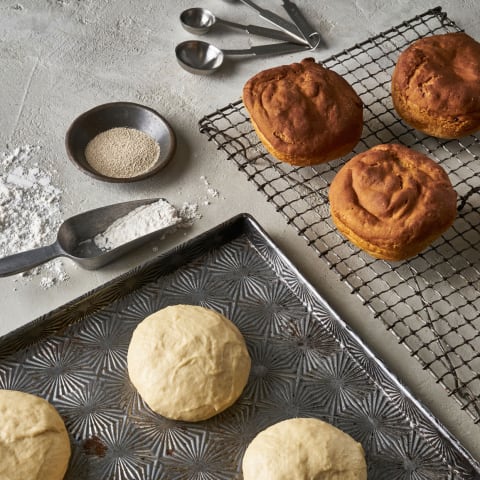The short answer: It’s an awesome, healthy alternative to cornstarch (and a few other questionable ingredients you may want to avoid); and yes, you should consider using it to upgrade the texture of sweet and savory recipes. Think of it as your secret weapon for thickening up sauces and fillings, adding a crisp finish to meats and veggies, and lightening up gluten- or grain-free baked goods that might otherwise be too heavy or dense. Today, the uses for arrowroot powder are much tastier—and far less intense. It’s commonly used as a thickening agent for fruit fillings, soups, and sauces and added to baked goods like muffins, cookies, and cakes for a lighter, spongier texture. “I often use it as a paleo alternative to cornstarch in savory cooking,” says Phoebe Lapine, gluten-free chef, mindbodygreen Collective member, and author of The Wellness Project. “Especially with sauces that need to be a bit heftier, arrowroot can give your mixtures some gelatinous thickness—perfect for holiday gravies!” In recipes calling for cornstarch, arrowroot powder can typically be used as a one-to-one substitute, and in recipes that call for flour as a thickener (e.g., to create a roux), arrowroot powder can be used in its place at a ratio of 1 teaspoon arrowroot powder per 1 tablespoon flour. Not only is it one of the most easily broken-down starches, but it’s been shown to alleviate diarrhea and abdominal pain. This may be due to the fact that arrowroot has demulcent properties—meaning, it’s a substance that soothes irritation and inflammation of the mucus membranes (including those in the gut) by forming a protective film. For these reasons, arrowroot powder may be a smart starch and/or flour substitute for people looking to support gut health. However, despite arrowroot powder’s relative ease of digestion, people dealing with serious issues like a leaky gut or irritable bowel syndrome may not always be able to tolerate it—at least initially. Arrowroot is not allowed on the GAPS Diet, which is designed specifically to treat chronic inflammatory conditions in the digestive tract because starches can be difficult for those with a compromised gut to properly digest. Once you’ve sufficiently healed your gut, however, arrowroot is thought to be one of the gentlest starches to first reintroduce. One important note is that arrowroot should typically be mixed with a room-temperature liquid before being added to a hot liquid, and it’s best to add arrowroot toward the end of cooking. “I typically use it toward the end because it can become a little too jelly-like with extended periods of cooking,” says Lapine. “I used it recently in a mushroom stroganoff recipe I was recreating to be gluten-free, adding it after the veggies were fully cooked.” Another great place arrowroot can work its binding magic is in veggie burgers, plant-based “meat” loaves, or these drool-worthy Gluten-Free Veggie Waffles. Fast-forward to today, however, and healthy foodies have mastered the grain-free baked good by tweaking their recipes to contain the right ratios of alternative flours to starches and other ingredients. These Vegan, Grain-Free Chocolate Chip Cookies are perfectly chewy, these Gluten-Free Sweet Teff Pancakes mimic your favorite diner short stack, and these Paleo Cinnamon Rolls definitely won’t crumble on contact—all thanks in part to arrowroot powder. If you can’t find arrowroot powder at your local grocery store (it’s often found in the healthy baking section), reputable online retailers to consider include Nuts.com, Mountain Rose Herbs, Bob’s Red Mill, and Thrive Market. Arrowroot powder should be stored in a cool, dry, dark place. Consider transferring it to an airtight container if it doesn’t come sold in a resealable bag. If you live in a warm climate, store it in the fridge. Stored properly, arrowroot powder should retain its beneficial properties for two to three years.



